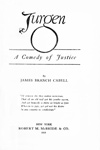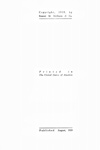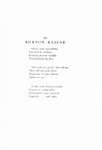James Branch Cabell : An Illustrated Bibliography
JURGEN: A Comedy of Justice
McBride Printings
Hall Code |
Description |
Jur-A2 |
Second Printing 1919 |
COMPILATION
Full Title:
Title page recto: Jurgen | [rule broken by the lower portion of the "g"] | [in italic] A Comedy of Justice | [rule] | By | James Branch Cabell | [in italic]"Of JURGEN eke they maken mencioun | That of an old wyf gat his youthe agoon, | And gat himselfe a shirte as bright as fyre | Wherein to jape, yet gat not his desire | In any countrie ne condicioun." | NEW YORK | ROBERT M. McBRIDE & CO. | 1919 (see image above).
Title page verso: Copyright, 1919, by | Robert M. McBride & Co. | [rule] | [in italic]Printed in | The United States of America | [rule] | Published August, 1919 (see image above).
Publication:
New York: Robert M. Mc Bride & Co., November, 1919
Collation:
Crown octavo [20 cm. (7⅞ in.) x 14 cm. (5½ in.)]; pp. (viii) + 368; P. (i) half-title; (ii) [all enclosed in single rule box] Books by Mr. Cabell ; (iii) title-page; (iv) publication data; (v) dedication; (vi) three quotations attributed to Philip Borsdale, E. Noel Codman, and John Frederick Lewistam); (vii-viii) Contents; (1) Fly-title (verso blank); (3-5) text of A Foreword;(6) blank; (7) fly-title (verso blank); followed by text pp. 9-368.
Binding:
Red-brown cloth; top edge trimmed, otherwise uncut; gilt lettering and decorations on front cover and spine. Spine: Jurgen | [rule] | Cabell | McBride. Front cover: Jurgen | [within the lower portion of the "g"] James | Branch | Cabell (see image above).
Dedication:
TO | BURTON RASCOE; followed by dedication in acrostic verse of three quatrains (see image above).
Dust jacket:
White paper; lettering and decorations in brown (see image above).
Spine: [in italic] JURGEN | device | CABELL | $2.00 | NET | McBRIDE.
Front panel: Jurgen | [next two lines enclosed in lower portion of "g"| [in italic] by | James Branch Cabell | "Cabell is a writer with style as individual and alive as | Anatole France's. It is flexible, humorous, dramatic, | - above all, personal. That of itself, in these days of sloppy | and colourless writing is enough to make Cabell important: | but any man who can plan a book of 'Jurgen's' kind on so ex- | tensive a scale and then carry it through without making it | labored and tedious is no small artist. 'Jurgen' is surely a | book that should make Americans proud. I am delighted | with its delicacy and good-temper and tenderness, its fancy | and its wit. If Americans are looking for a book to show to | Europe here it is." | - Hugh Walpole | [rule] | ROBERT M. McBRIDE & CO., Publishers | Union Square New York | [rule].
Rear panel in brown: What the Reviewers Say of | Jurgen | by JAMES BRANCH CABELL | Author of "Beyond Life," "The Cream if the Jest," "The Rivet in Grandfather's | Neck," etc. | [double rule]| [seven reviews of Jurgen from Joseph Hergesheimer, Burton Rascoe in The Chicago Tribune, Chicago Daily News, Philadephia Press, New York Tribune Springfield (Mass.) Courier, and Belford Forrest in The Knickerbocker Press] | [in italic] 12 mo. 368 pages. $2.00 net. Postage extra | At All Booksellers | [double rule] |ROBERT M. McBRIDE & CO., Publishers | UNION SQUARE | [three devices] |NEW YORK
Front & rear flaps: blank
Notes:
Fifteen hundred copies of the first printing were issued in September, 1919 (not August as stated in the verso of the title page). The second printing (Jur-A2, issued November , 1919) is textually identical to the first and has the same printed August publication date. Because of this, it is almost universally referred to in the trade as the "second state" of the first printing, but all previous bibliographers agree it is actually a separate second printing. The two printings can be distinguished by the width of the binding [~3.5 cm. (1 3/8-in.) in the first binding, ~4.1 cm. (1 5/8-in.) in the second], and by the broken rule at the top of p. 144 in the second printing (it is intact in the first) (see comparative illustrations above).







